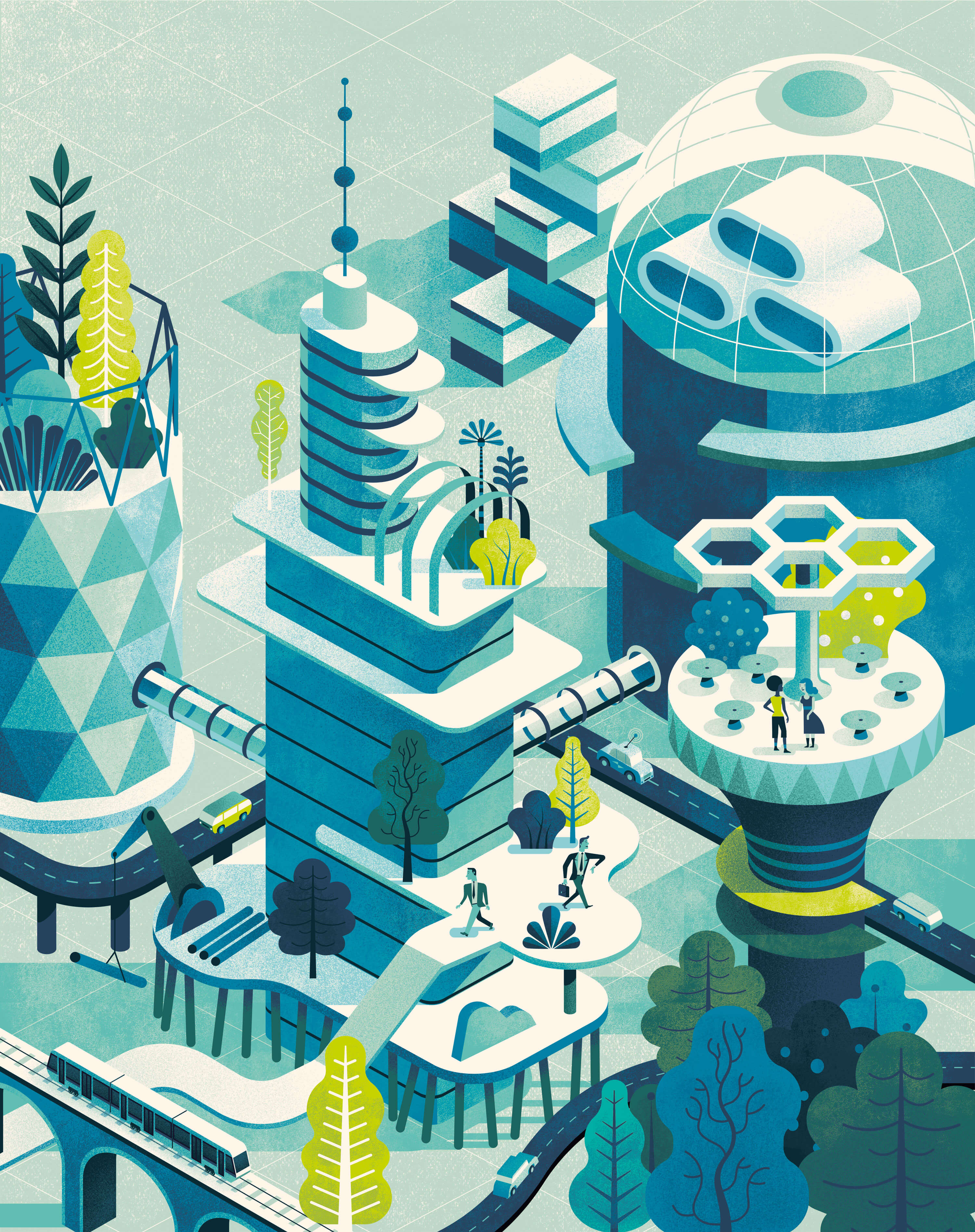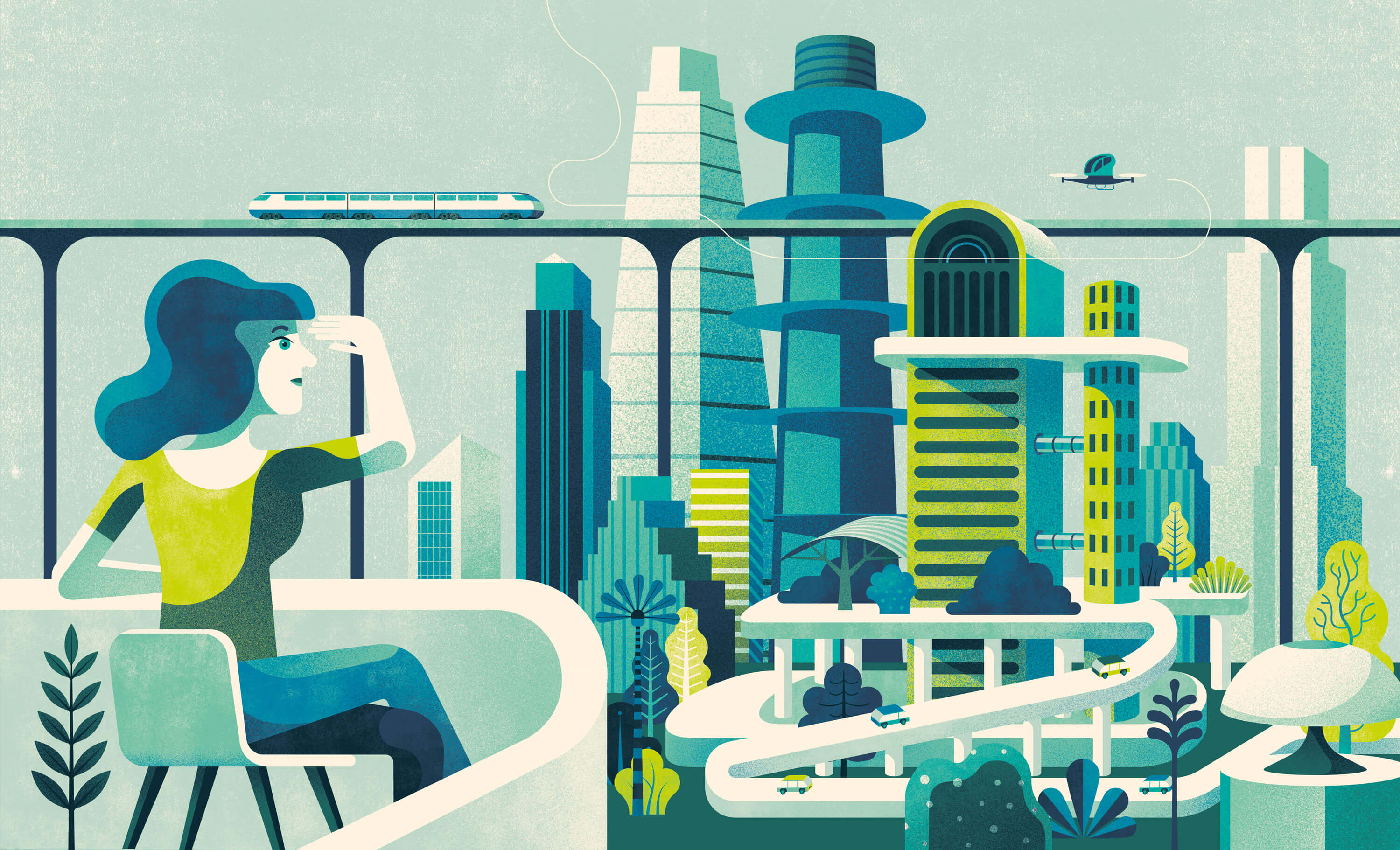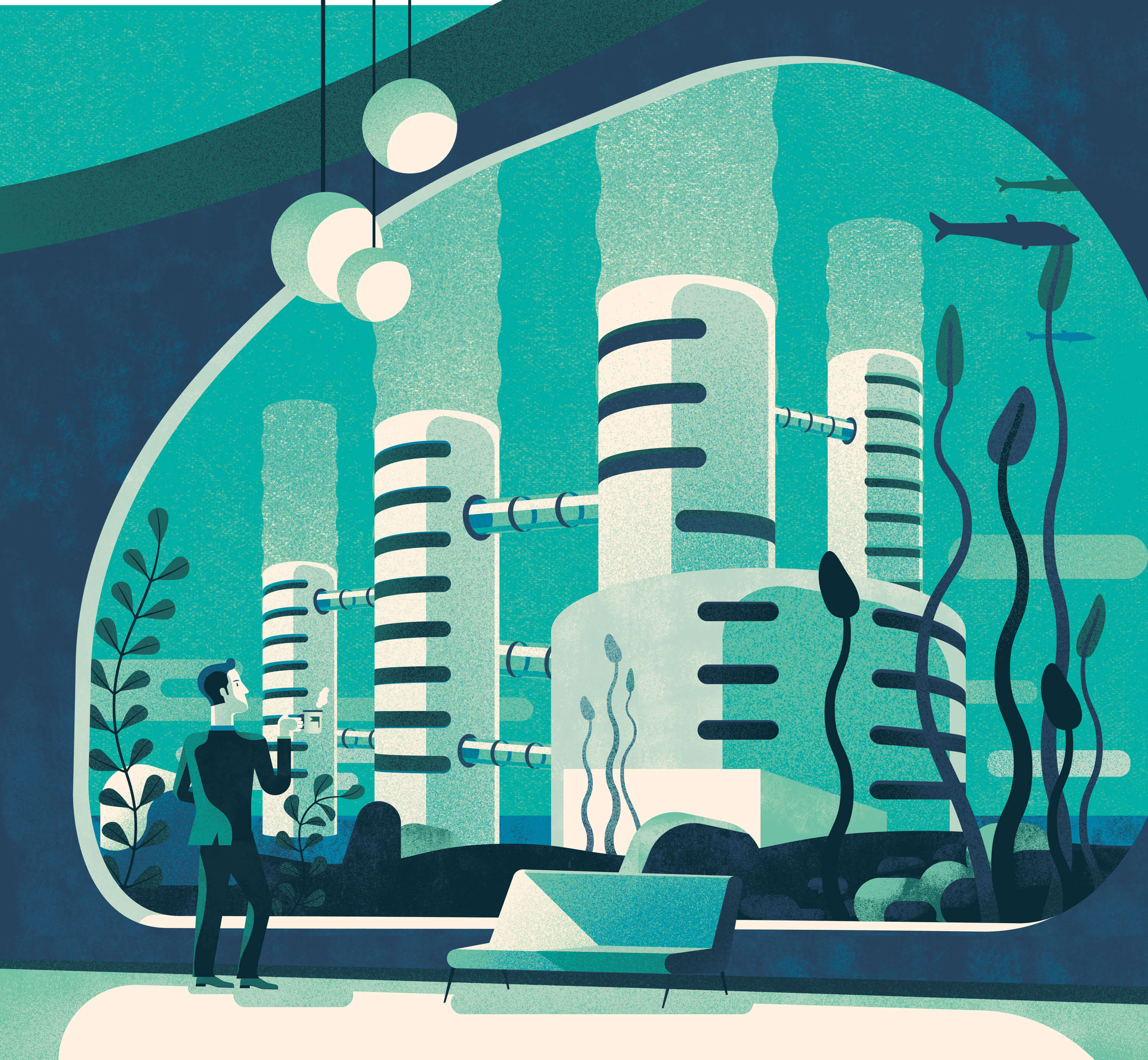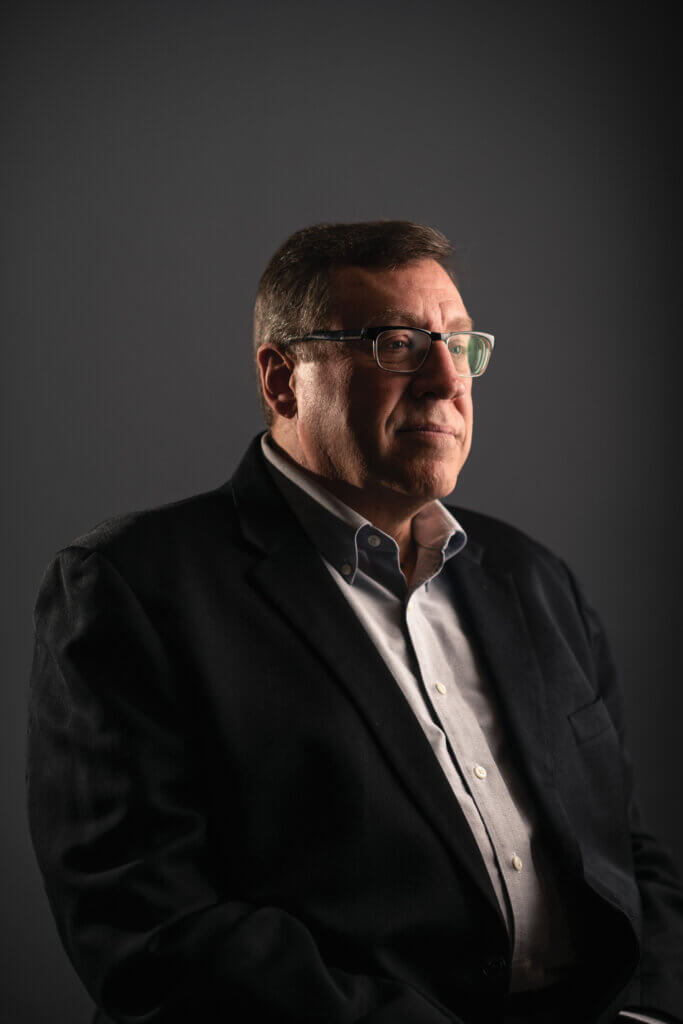
Building Tomorrow
Jerry Buckwalter ’81 has spent much of his career forecasting the future.
He started in high-tech engineering after studying physics at Monmouth but gravitated to the kinds of big-picture, strategic roles his fellow engineers eschewed in favor of “designing the next box.”
Eventually landing at Northrop Grumman, Buckwalter was tasked with exploring future global scenarios for the military contractor to help shape long-term strategic planning. Now at the American Society of Civil Engineers (ASCE), his key charge is championing the Future World Vision project, an immersive, collaborative, educational experience that imagines what the world’s infrastructure systems might look like five decades from now. “The research that I did at Northrop Grumman—that, because of its classification level, has never seen the light of day beyond the military and the intelligence community—has convinced me that there are many global trends converging,” says Buckwalter, naming autonomy, artificial intelligence, synthetic biology, climate change, and wild demographic swings, among others. “And we’re going to see more change in the next 50 years than we’ve seen in hundreds of years, maybe over a thousand years.”
Those massive changes will impact our infrastructure in extreme ways: Among the scenarios the Future World Vision project predicts are megacities built using materials with biological functionality, floating cities created in response to rising sea levels, and even large-scale settlements built on Mars. “The future could look so radically different,” says Buckwalter.
In this conversation with Monmouth magazine, Buckwalter discusses why it’s important to understand where we’re headed, how the pandemic’s impact could shape future cities, and what gives him hope for 2070.
How is the Future World Vision project different from the visioning work you’ve done previously?
Future World Vision is the same kind of future scenario planning tool that I’ve used before, but now I get to use it in the public domain—and for a different purpose.
But I’ve also lived long enough now to realize that if you’re dealing with something that’s not in a restricted environment like I used to work in, and you’ve got to affect a wide range of people … well, most people aren’t nerds like me. They’re not going to read a 300-page report. So we had to figure out how to turn our analysis into a visual, immersive, interactive project. Otherwise, it’s difficult to understand, it never gets embraced, and action doesn’t occur. I want to create action, and this is an effective way to do it. Because if we just keep designing the built environment the way we do now, climate issues, greenhouse gas and carbon footprint issues, and demographic inequities that are bad now will only get worse. This is the moment that we can really make a change. This project helps us prepare for how we’re going to change that, because once these infrastructure assets are built, it’s hard to change.
So this is a tool designed to force us to discover those things early enough that we can begin to change the way both civil engineers and political leaders think about the built environment—and define the outcomes we desire from a long-term perspective instead of just on short election-year cycles. That way, we can begin to do what our citizenry needs now but also begin to do what the next generation will need 20 to 30 years from now.

You described this as a tool. Who is it built for, and how do they use it?
It’s an educational tool designed to help all vested parties collaborate for a better future. Some of the first adopters are a few universities that have taken the project material and research and are exploring ways to embed that into their engineering curricula. These students are going to be at the peak of their careers 30 years from now, and we’re giving them a picture of what infrastructure will look like 30 years from now—which, by the way, will have features that are organic, bioengineered, powered by artificial intelligence, and adaptable, not just the concrete, glass, and steel that you see today.
So it’s preparing students to be future leaders, not just what I’ll call the “shovel-ready” engineers the industry needs when that engineer graduates next year. The forward-leaning institutions are starting to discover they have a responsibility to do both: produce engineers who are ready to go to work because we need them desperately, but who will also be tomorrow’s leaders because they’ve thought about what infrastructure might look like 30 years from now.
Here’s the nice part: It’s a virtual platform. Once we download it to a professor and his or her students at, say, Monmouth, we can give it to a similar professor in Shanghai or Bogotá or Amsterdam, and they can work on projects together. It increases the ability of students to think about the global world they live in and how infrastructure affects the way people live with cultural differences or with climatic differences. I also know some engineering consulting firms that are using it to help them think through how they do strategic planning for their engineering companies so that they’re relevant in the future.
Over time, I also want this to be used by government leaders so that they can better communicate to their citizens. It can help civic leaders describe why you’re building a road, why you’re building a bridge—the benefit to quality of life or the societal benefit—by visualizing it. Infrastructure assets are long-life-cycle assets. If you build a bridge, it’s going to be there for the next 50 to 100 years or longer. So why would you not look at the role of that bridge 50 years from now? That’s what you’re asking your taxpayers to fund and to support and to maintain.

The project was unveiled in 2019, but one of the disruptive global events that the team considered when building these scenarios was a global pandemic. What did you forecast about the impact of a pandemic—and how can it shape the future of cities?
We weren’t being that clever when we considered the possibility of a pandemic. We wanted to consider some disruptive elements because that helps people think through what they are going to do if those happen. We picked three of them: a global pandemic, a global GMO-based food shortage, and a catastrophic regime change somewhere in the world. What are the things we have to think about regarding our infrastructure should those three types of things happen?
Let’s take the pandemic’s impact on sustainability, for example. The first thing that we knew would happen is that people would lock down. The world always quarantines during pandemics. It has for thousands of years. So, therefore, emissions will go down because nobody’s on the road. That’s a sure phenomenon. Here’s the next problem: When they do get back on the road, less of them want to use public transit because they can’t socially distance. So we thought about, OK, well, what about the ubiquitous internet connectivity that enables people to work virtually and remotely? We saw that happen in spades with COVID-19. It simply accelerated what we thought in Future World Vision would be a five- to 10-year phenomenon to a six-month phenomenon.
But in the 10- to 20-year time frame, mass transit could easily be retuned to have individualized compartments so that people could get back to the kind of community, interpersonal interaction that the human psyche needs and not have to get in their cars. We can create those kinds of social separations through the built environment such that you could densely pack people in and still keep them safe.
Engineers are great problem-solvers. I’m just trying to make sure they’re asking themselves those kinds of questions about the future so that we don’t create built environments that we regret 30 years from now.
Then we looked out further and said for ultimate sustainability, we actually see technologies on the horizon that, in 20-plus years, could create antimicrobial, wearable technology so that you can intermingle and be protected from a pandemic virus in a way that is not possible today.
You can use that same mental experiment with a food shortage or anything else, but relative to a pandemic, what we want the Future World Vision to do is allow, let’s say, New York City’s public transit system to consider not only how much funding it will need to get people to work in the aftermath of COVID-19, but also what would allow it to maintain normalcy if this happened again in 15 or 20 years.
Every four years, ASCE releases an infrastructure report card for the U.S., and in 2021, the country got a C-. It’s the first time it’s been better than a D since 1988. After months of partisan debate, a $1 trillion infrastructure bill was signed into law recently, and while it’s the largest federal investment in infrastructure in more than a decade, many note it’s woefully late. Why is it so hard to get people to care about such a vital issue? And is that a challenge for Future World Vision?
We’re in one of the peak eras of government mistrust. No matter what a leader says, there’s a certain amount of the population that simply says, “I’m not listening because I don’t trust them anymore.” That’s not partisan. That’s on both sides of the aisle.
There is just so much superficial information—tidbits or soundbites—and it’s not actually helping people understand the issues. We have to find a way to better impartially communicate complex interrelated issues in a way that’s digestible to the average person. That is a heck of a challenge, but that’s why we don’t have the sense of urgency. We’re confused.
I’ve studied many companies, industries, and governmental entities. There are a lot of examples of organizations that have a long history of experience, and, therefore, their managers make decisions to make certain investments or to go down a certain path that’s perfectly rational based on the past. But if they haven’t experienced something like Future World Vision, they’re not seeing that the past is sometimes not a proper guidepost.

I’ll give you an example. If you go back to the early 1900s, London pulled together engineers from all over the world to deal with what was said to be the upcoming crisis: sanitary conditions on the streets of London and every major city of the world because of horse-drawn transportation and the dung that was piling up. They made projections—based upon population growth and feed for horses and carriage use—that in 20 or 30 years, London would be knee-deep in dung. Well, guess what? Not only was it wrong; it was ridiculous. Why? It was ridiculous because nobody could envision the horseless carriage.
Now let’s take that a step further. When the automobile arrived, engineers declared it to be an environmental savior because all this dung was gone. We certainly think about that differently now, 100 years later. I’ve looked at all the analyses associated with electric cars and alternative power. Guess what? I don’t believe we’re thinking it through well. I think we might look back in 100 years and say, “Why did we think electric cars were going to solve this problem?” We latch onto things like, “Well it’s electric. It doesn’t produce greenhouse gas.” Well, yes it does, because there are greenhouse gas emissions from the power sources that generate the power that charges the electric car. And what about additional issues associated with the lithium battery and the mining of materials? You have to look at all of that. That’s the complexity of the way things emerge in the world. And if you’re thinking about ground transportation, you should be weighing all those things.
Again, engineers are great problem-solvers. I’m just trying to make sure they’re asking themselves those kinds of questions about the future so that we don’t create built environments that we regret 30 years from now.
You have a couple of beta projects underway, as you mentioned. What early impacts from the project are you seeing that give you hope for 2070?
I’m seeing some early promise with new materials research and development. There is unbelievable promise there that could give us huge leverage in making massive changes to both quality of life and environmental conditions. I mean, we’ve been pouring concrete since the Romans. We then had a revolution with the advent of steel, and it made a massive difference. We could build skyscrapers. I think we’re due for the next materials revolution. I find it very encouraging to think that if we get it right, something will emerge and allow us to have another structural revolution.
Another area is energy. There’s a lot of focus now on alternative energy, but most of it is not addressing scalability. If we’re going to tackle the United Nations climate goals, current plans are not getting us very close to those. The gap is unbelievable, but at least people are focused on it, so it’s got a chance.
Another area is digital infrastructure. When we apply sensors and big data computational capability to our physical infrastructure, we will be able to greatly increase its productivity and usefulness. We will also increase the ability of our built environment to be more personalized to meet our needs. However, we will need to advance our cybersecurity capabilities to ensure that it is not misused as well.
Lastly is transportation. I think there are people starting to think about what autonomous transportation looks like. What are the benefits? What are the downsides? What does transportation as a service look like versus people owning cars? What about in, let’s say, 20 years when autonomous transport could be aerial and surface transportation could be even less important? And then, by the way, what do we do with all the roads that we built? We don’t need them anymore, or we won’t be using them the same way we do now. I think there are people starting to think about the complex change that’s occurring based upon shared, autonomous, alternatively fueled transportation. That’s a good starting point.